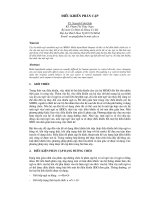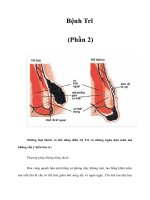Tài liệu Digital Photography - Phần 2 pptx
Bạn đang xem bản rút gọn của tài liệu. Xem và tải ngay bản đầy đủ của tài liệu tại đây (53.66 KB, 6 trang )
Tìm hiểu về Digital Photography – Bài thứ 2
( tiếp theo kỳ trước)
Dưới đây là bài học ngắn về digital photography góp nhặt từ
Internet- Bài này được tác giả là giáo sư nhiếp ảnh Dennis Curtin cho
phép đăng lại để dùng vào mục đích giáo dục. Mỗi kỳ báo sẽ có một
chương ngắn về đề tài digital để chúng ta cùng học thêm. Tuy nhiên
chúng ta nên nhớ rằng : Kiến thức căn bản cần được trau dồi trước đã, và
từ những bài học căn bản nhiếp ảnh của các máy chụp phim và khía cạnh
nghệ thuật lãnh hội qua các lớp học căn bản. Ta sẽ sáng tạo ra nhiều hình
ảnh giá trị, dùng bất cứ phương thức nào cũng được. Xin các bạn chịu
khó đọc bài này bằng tiếng Anh nguyên bản.
Free photography, photographic freedom
Although it's both the immediacy and flexibility of digital
photography that has made it so popular, there is one aspect that is rarely
mentioned. This is the new freedom it gives you to explore creative
photography. In the 1870's when William Henry Jackson was carrying 20
x 24 glass plate negatives around the West on a mule, you can bet he
hesitated before he took a photograph. We may not be carrying window-
sized glass plates, but you and I also hesitate before taking a picture.
We're always doing a mental calculation "is it worth it?" Subconsciously
we're running down a checklist of costs, times, effort, and so on. During
that "decisive moment," the image is often lost or we fail to try new
things. We lose the opportunity for creative growth and choose to stay
with the familiar that has delivered for us in the past. Surprisingly,
Jackson had one big advantage we've lost over the last century. If an
image didn't turn out, or if he was out of glass plates, he could just scrape
the emulsion off a previously exposed negative, recoat the plate, and try
again. Digital photography not only eliminates that nagging "is it worth
it?" question, it also returns us to that era of endlessly reusable film (and
we don't need a mule to carry it). Hand the camera to the kids, take weird
and unusual angles, shoot without looking through the viewfinder, and
ignore all previously held conceptions about how to take photographs.
You may be surprised at the photos you get if you exploit this new era of
uninhibited shooting.
The three steps of digital photography
Digital cameras are just one link in a long chain leading from the
original scene through to the final image that you display or distribute. In
fact, a digital camera isn't even an absolutely necessary link in the chain.
The key element in digital photography is an image in a digital format
made up pixels. Although a digital camera captures photos in this digital
format, you can also scan slides, negatives, or prints to convert these
traditional images into the same digital format.
To understand how the camera fits in with other parts of the digital
photography system, it helps to understand the three basic steps involved
in creating and using digital photographs-input, processing, and output.
Step 1. Inputting photographs
Input devices get photographs or other data into a computer system.
The input device you're probably most familiar with is the keyboard.
However, there are hundreds of other input devices including mice, touch
pads, voice recognition systems, scanners, and so on. Here are some of
the input devices you can use to create digital photographs:
Digital still cameras capture photographs in a digital format.
Film cameras capture photographs on slides, negatives, or prints
which you can then scan to convert them to digital photographs.
Video cameras capture images in a video format. You can then use
a frame grabber to isolate out individual frames and save them as still
images.
Digital video cameras sometimes are able to capture still images
just like a digital still. You can also use a video-editing card to extract
still images from the digital video.
Step 2. Processing photographs
Once a photograph is in digital form, you can store it on your
system and then edit or manipulate it with a photo-editing program such
as Photoshop. The things you can do to a digital image are almost endless.
In some cases you improve an image by eliminating or reducing its flaws.
In other cases, you adjust an image for other purposes, perhaps to make it
smaller for e-mailing or posting on a Web site. Finally, you might take an
image to a new place, making it something it never was. Here are just a
few of the ways you can process images:
Crop the photograph to emphasize the key part.
Reduce the number of pixels in an image to make it smaller for
posting on the Web or e-mailing.
Use filters to sharpen it or even make it look like a watercolor or
oil painting.
Stitch together multiple frames to create panoramas.
Merge two images to create a 3D stereo effect, or an animated
image for display on the Web.
Change brightness and contrast to improve the image.
Cut and paste parts of one image into another to create a photo
montage.
Convert the photograph to another format.
Step 3. Outputting photographs









